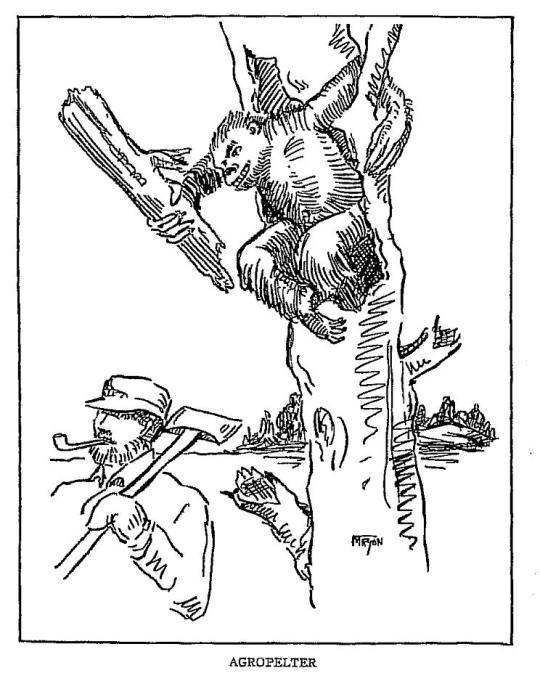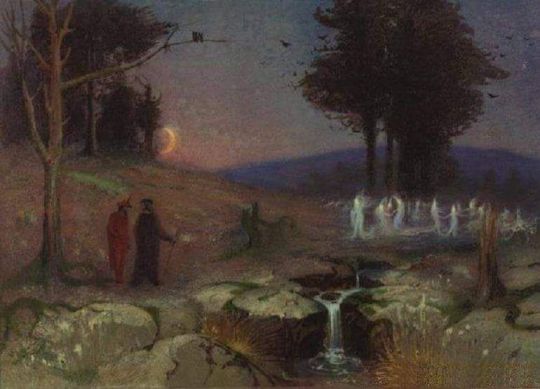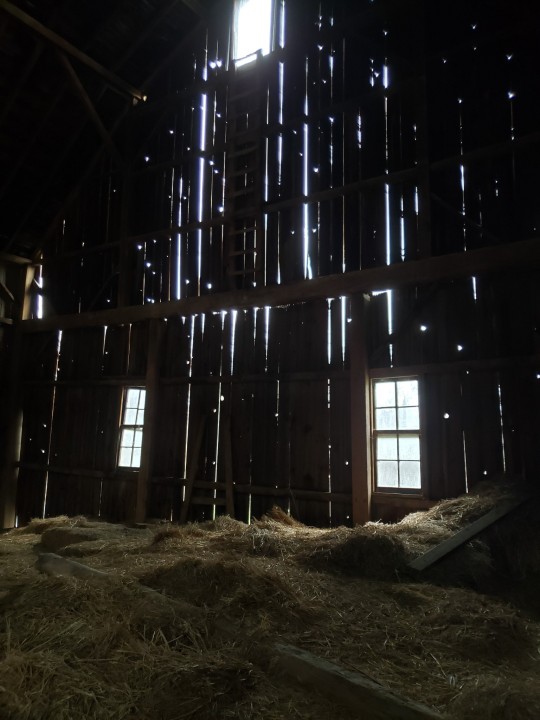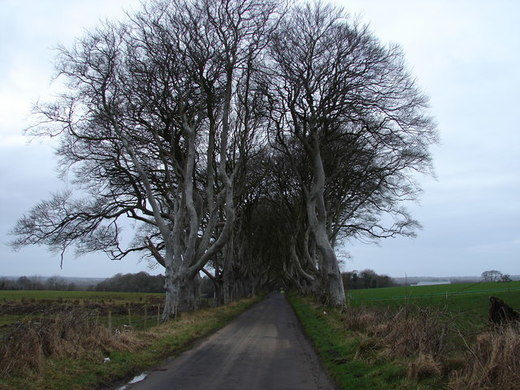Photo

After investigating the case in 2000, Joe Nickell of the Committee for Skeptical Inquiry concluded that the bright light in the sky reported by the witnesses on September 12 was most likely a meteor, that the pulsating red light was likely an aircraft navigation or hazard beacon, and that the creature described by witnesses closely resembled an owl. Nickell suggested that witnesses' perceptions were distorted by their heightened state of anxiety. Nickell's conclusions are shared by a number of other investigators, including those of the Air Force.
The night of the September 12 sighting, a meteor had been observed across three states—Maryland, Pennsylvania and West Virginia. According to Nickell, three flashing red aircraft beacons were also visible from the area of the sightings, which could account for descriptions of a pulsating red light and red tint on the face of the supposed monster.
Nickell concluded that the shape, movement, and sounds reported by witnesses were also consistent with the silhouette, flight pattern, and call of a startled barn owl perched on a tree limb, leading researchers to conclude that foliage beneath the owl may have created the illusion of the lower portions of the creature (described as being a pleated green skirt). Researchers also concluded that the witnesses' inability to agree on whether the creature had arms, combined with May's report of it having "small, claw-like hands" which "extended in front of it", also matched the description of a barn owl with its talons gripping a tree branch.
According to skeptic Ryan Haupt, even though local boy Max Lockard admitted he had driven around the site "hoping to see something" in his Chevy truck, "paranormal investigators concluded that the tracks, oily residue, and bits of a rubbery substance must have been left by the creature and not the truck". Haupt explains nausea reported by some of the witnesses as a symptom "consistent with hysteria and over-exertion".
-Wikipedia
34 notes
·
View notes
Photo

At 7:15 p.m., on September 12, 1952, two brothers, Edward and Fred May, and their friend Tommy Hyer, said that they saw a bright object cross the sky and land on the property of local farmer G. Bailey Fisher. The boys went to the home of Kathleen May, where they told their story. May, accompanied by the three boys, local children Neil Nunley and Ronnie Shaver, and West Virginia National Guardsman Eugene Lemon, went to the Fisher farm in an effort to locate whatever it was that the boys had said they had seen. The group reached the top of a hill, where Nunley said they saw a pulsing red light. Lemon said he aimed a flashlight in that direction and momentarily saw a tall "man-like figure with a round, red face surrounded by a pointed, hood-like shape".
Descriptions varied. In an article for Fate Magazine based on his tape-recorded interviews, UFO writer Gray Barker described the figure as approximately 10 feet (3 m) tall, with a round blood-red face, a large pointed "hood-like shape" around the face, eye-like shapes which emitted greenish-orange light, and a dark black or green body. May described the figure as having "small, claw-like hands", clothing-like folds, and "a head that resembled the ace of spades". According to the story, when the figure made a hissing sound and "glided toward the group", Lemon screamed and dropped his flashlight, causing the group to run away.
September 14, 1952, news clip from the Charleston Daily Mail
The group said they had smelled a "pungent mist" and some later said they were nauseated. The local sheriff and a deputy had been investigating reports of a crashed aircraft in the area. They searched the site of the reported monster but "saw, heard and smelled nothing". According to Barker's account, the next day, A. Lee Stewart Jr. of the Braxton Democrat claimed to have discovered "skid marks" in the field and an "odd, gummy deposit" which were subsequently attributed by UFO enthusiast groups as evidence of a "saucer" landing.
According to former news editor Holt Byrne, "newspaper stories were carried throughout the country, radio broadcasts were carried on large networks, and hundreds of phone calls were received from all parts of the country". The national press services rated the story "No. 11 for the year". A minister from Brooklyn came to question the May family. A Pittsburgh paper sent a special reporter. UFO and Fortean writers like Gray Barker and Ivan T. Sanderson arrived to investigate.
-Wikipedia
17 notes
·
View notes
Photo
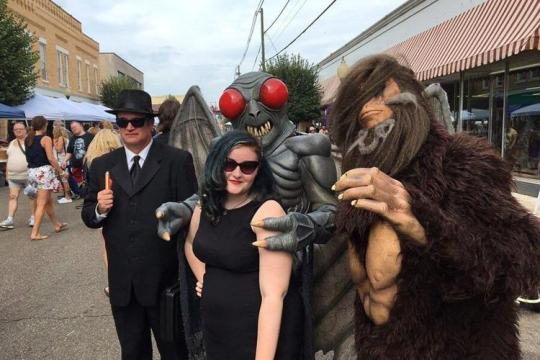
Point Pleasant held its first Annual Mothman Festival in 2002. The Mothman Festival began after brainstorming creative ways for people to visit Point Pleasant. The group organizing the event chose the Mothman to be the center of the festival due to its uniqueness, and as a way to celebrate its local legacy in the town.
According to the event organizer Jeff Wamsley, the average attendance for the Mothman Festival is an estimated 10–12 thousand people per year. A 12-foot-tall metallic statue of the creature, created by artist and sculptor Bob Roach, was unveiled in 2003. The Mothman Museum and Research Center opened in 2005. The festival is held on the third weekend of every September, hosting guest speakers, vendor exhibits, pancake-eating contests, and hayride tours of locally notable areas.
50 notes
·
View notes
Text
Mothman
Folklorist Jan Harold Brunvand notes that Mothman has been widely covered in the popular press, some claiming sightings connected with UFOs, and others claiming that a military storage site was Mothman's "home". Brunvand notes that recountings of the 1966–67 Mothman reports usually state that at least 100 people saw Mothman with many more "afraid to report their sightings" but observed that written sources for such stories consisted of children's books or sensationalized or undocumented accounts that fail to quote identifiable persons. Brunvand found elements in common among many Mothman reports and much older folk tales, suggesting that something real may have triggered the scares and became woven with existing folklore. He also records anecdotal tales of Mothman supposedly attacking the roofs of parked cars occupied by teenagers.
Conversely, Joe Nickell says that a number of hoaxes followed the publicity generated by the original reports, such as a group of construction workers who tied flashlights to helium balloons. Nickell attributes the Mothman stories to sightings of barred owls, suggesting that the Mothman's "glowing eyes" were actually red-eye effect caused from the reflection of light from flashlights or other bright light sources. Benjamin Radford points out that the only report of glowing "red eyes," was secondhand, that of Shirley Hensley quoting her father.
According to University of Chicago psychologist David A. Gallo, 55 sightings of Mothman in Chicago during 2017 published on the website of self-described Fortean researcher Lon Strickler are "a selective sample". Gallo explains that "he's not sampling random people and asking if they saw the Mothman – he's just counting the number of people that voluntarily came forward to report a sighting." According to Gallo, "people more likely to visit a paranormal-centric website like Strickler's might also be more inclined to believe in, and therefore witness the existence of, a 'Mothman'."
Some pseudoscience adherents (such as ufologists, paranormal authors, and cryptozoologists) claim that Mothman was an alien, a supernatural manifestation, or a previously unknown species of animal. In his 1975 book, Keel claimed that the Point Pleasant residents experienced precognitions including premonitions of the collapse of the Silver Bridge, UFO sightings, visits from inhuman or threatening men in black, and other phenomena.
-Wikipedia
20 notes
·
View notes
Text
Fearsome Critters
Agropelter, a beast that amuses itself by hurling twigs and tree branches at passersby.
Axehandle hound, a beast that reputedly subsists on axe-handles left unattended, mentioned in Jorge Luis Borges' Book of Imaginary Beings.
Ball-tailed cat, a feline similar to a mountain lion, except with a long tail with a bulbous end used for striking its prey.
Bigfoot is an alleged ape/human-like hybrid creature of North American folklore.
Cactus cat, a feline of the American Southwest with hair-like thorns that intoxicates itself by the consumption of cactus water.
Dungavenhooter, a crocodile creature with no mouth and huge nostrils. The creature uses its tail to pound loggers into a gaseous vapor, which it then inhales for sustenance.
Glawackus, an animal resembling a mixture of a lion, boar, or bear.
Gumberoo, a rare, hairless bear-like creature with nearly invulnerable skin. The animal's hide repels anything fired at it. Fire causes the gumberoo to combust in a massive explosion.
Hidebehind, an animal that seizes loggers and devours them. The animal was said to be so swift that it could hide behind the nearest tree before being seen.
Hodag, a creature of the Wisconsin swamps possessing horns and spines.
Hugag, an animal similar to a moose, with stiff, jointless legs, and a large upper lip preventing it from grazing or lying down.
Jackalope, a jackrabbit with the antlers of an antelope or deer.
Jersey Devil, a predatory creature that inhabits the pine forests of Southern New Jersey. The creature is often described as winged and bipedal, and sometimes connected to witchcraft and devil worship.
Sidehill gouger, an animal legged for hillsides having legs on one side taller than the other, thus always having to travel on hillsides.
Splintercat, a legendary cat of the Pacific Northwest that uses its incredible speed and stiff forehead to smash into large trees, knocking the branches off and withering the trunks.
Squonk, an animal which, saddened by its deformed countenance, cries incessantly and even dissolves into tears if seen.
Teakettler, a small variety of vermin that makes a noise like a teakettle.
Wampus cat, a large phantom panther that varies widely in appearance.
Whirling Whimpus, a gorilla-like monster with large arms and horse-like hooves, with the ability to spin around into a small tornado to catch prey, similar to Taz of Looney Tunes fame.
Belled buzzard, a vulture with a bell affixed to it. The ringing of which is cited as an omen of disaster.
Gillygaloo bird, a bird that lays square eggs, so they do not roll.
Goofus bird, a backwards-flying bird that builds its nest upside down.
Fur-bearing trout, a species of trout that grows a thick fur coat for warmth in cold climates.
Hoop snake, a snake that bites its tail to enable it to roll like a wheel.
Joint snake, a snake that can reassemble itself after being cut to pieces or break apart when hit with something.
Snallygaster, a bird/reptile-like hybrid beast said to inhabit the hills surrounding Washington and Frederick Counties of Maryland
Snow snake, a snake that is active only during winter months.
-Wikipedia
24 notes
·
View notes
Text
Will O’ the Wisp
In European folklore, these lights are believed to be spirits of the dead, fairies, or a variety of other supernatural beings which attempt to lead travellers to their demise. Sometimes the lights are believed to be the spirits of un-baptized or stillborn children, flitting between heaven and hell.
Mexico has two equivalents as well. In one they are called brujas (witches), folklore explains the phenomenon to be witches who transformed into these lights. The reason for this, however, varies according to the region. Another explanation refers to the lights as indicators to places where gold or hidden treasures are buried which can be found only with the help of children, in this one they are called luces del dinero (money lights) or luces del tesoro (treasure lights).
The swampy area of Massachusetts known as the Bridgewater Triangle has folklore of ghostly orbs of light, and there have been modern observations of these ghost-lights in this area as well.
The fifollet (or feu-follet) of Louisiana derives from the French. The legend says that the fifollet is a soul sent back from the dead to do God's penance, but instead attacks people for vengeance. While it mostly takes part in harmless mischievous acts, the fifollet sometimes sucked the blood of children. Some legends say that it was the soul of a child who died before baptism.
-Wikipedia
0 notes
Quote
On visiting the spot at night, the sensitive flames retired as the major advanced; but on standing quite still, they returned, and he tried to light a piece of paper at them, but the current of air produced by his breath kept them at too great a distance. On turning away his head, and screening his breath, he succeeded in setting fire to the paper. He was also able to extinguish the flame by driving it before him to a part of the ground where no gas was produced; then applying a flame to the place whence the gas issued, a kind of explosion was heard over eight or nine square feet of the marsh; a red light was seen, which faded to a blue flame about three feet high and this continued to burn with an unsteady motion. As the morning dawned the flames became pale and they seemed to approach nearer and nearer to the earth, until at last they faded from sight.
Charles Tomlinson, On Certain Low-Lying Meteors (1893)
0 notes
Link
0 notes
Photo

MARTIN LEWIS
Twin Silos
Drypoint On Paper
10.375″ x 13″
98 notes
·
View notes
Photo




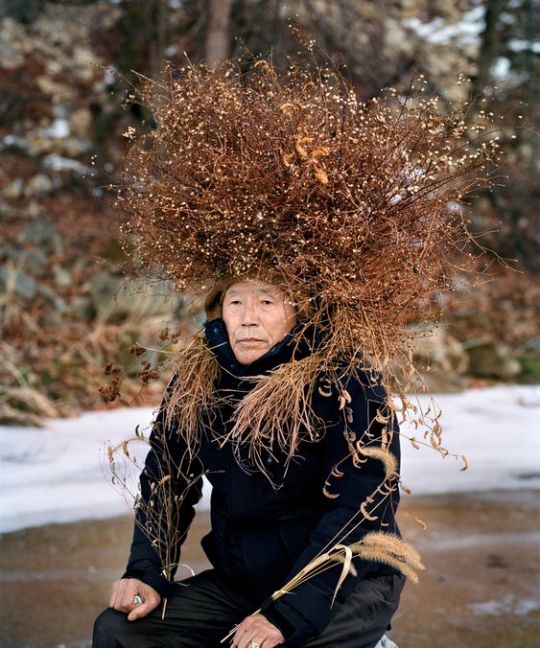
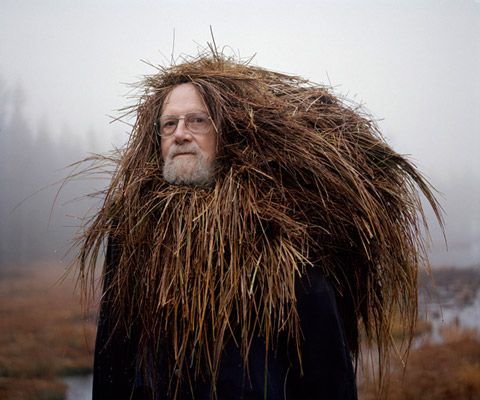
Eyes as Big as Plates - Karoline Hjorth and Riitta Ikonen
2 notes
·
View notes
Photo

There have been many claims of sightings and occurrences involving the Jersey Devil.
According to legend, while visiting the Hanover Mill Works to inspect his cannonballs being forged, Commodore Stephen Decatur sighted a flying creature and fired a cannonball directly upon it, to no effect.
Joseph Bonaparte, elder brother of Napoleon, is also claimed to have seen the Jersey Devil while hunting on his Bordentown estate about 1820.
During 1840, the Jersey Devil was blamed for several livestock killings. Similar attacks were reported during 1841, accompanied by tracks and screams.
In Greenwich during December 1925, a local farmer shot an unidentified animal as it attempted to steal his chickens, and then photographed the corpse. Afterward, he claimed that none of 100 people he showed it to could identify it. On July 27, 1937, an unknown animal "with red eyes" seen by residents of Downingtown, Pennsylvania was compared to the Jersey Devil by a reporter for the Pennsylvania Bulletin of July 28, 1937. In 1951, a group of Gibbstown, New Jersey boys claimed to have seen a 'monster' matching the Devil's description and claims of a corpse matching the Jersey Devil's description arose in 1957. During 1960, tracks and noises heard near Mays Landing were claimed to be from the Jersey Devil. During the same year the merchants around Camden offered a $10,000 reward for the capture of the Jersey Devil, even offering to build a private zoo to house the creature if it was captured.
During the week of January 16-23 of 1909, newspapers published hundreds of claimed encounters with the Jersey Devil from all over South Jersey and the Philadelphia area. Among these alleged encounters were claims the creature "attacked" a trolley car in Haddon Heights and a social club in Camden. Police in Camden and Bristol, Pennsylvania supposedly fired on the creature to no effect. Other reports initially concerned unidentified footprints in the snow, but soon sightings of creatures resembling the Jersey Devil were being reported throughout South Jersey and as far away as Delaware and western Maryland. The widespread newspaper coverage created fear throughout the Delaware Valley prompting a number of schools to close and workers to stay home. Vigilante groups and groups of hunters roamed the pines and countrysides in search of the Devil. During this period, it is rumored that the Philadelphia Zoo posted a $10,000 reward for the creature. The offer prompted a variety of hoaxes, including a kangaroo equipped with artificial claws and bat wings.
17 notes
·
View notes
Photo

Regal notes that, by the late 1700s and early 1800s at the latest, the "Leeds Devil" had become an ubiquitous legendary monster or ghost story in the southern New Jersey area. Into the early to mid-19th century, stories continued to circulate in southern New Jersey of the Leeds Devil, a "monster wandering the Pine Barrens". An oral tradition of "Leeds Devil" monster/ghost stories subsequently became established in the Pine Barrens area.
Although the "Leeds Devil" legend has apparently existed since the 18th century, Regal states that the more modern depiction of the Jersey Devil, as well as the now pervasive "Jersey Devil" name, first became truly standardized in current form during the early 20th century:
“During the pre-Revolutionary period, the Leeds family, who called the Pine Barrens home, soured its relationship with the Quaker majority ... The Quakers saw no hurry to give their former fellow religionist an easy time in circles of gossip. His wives had all died, as had several children. His son Titan stood accused by Benjamin Franklin of being a ghost ... The family crest had winged dragons on it. In a time when thoughts of independence were being born, these issues made the Leeds family political and religious monsters. From all this over time the legend of the Leeds Devil was born. References to the 'Jersey Devil' do not appear in newspapers or other printed material until the twentieth century. The first major flap came in 1909. It is from these sightings that the popular image of the creature—batlike wings, horse head, claws, and general air of a dragon—became standardized.”
Indeed, many references to a "Leeds Devil" or "Devil of Leeds" appear in earlier printed material prior to the widespread usage of the "Jersey Devil" name. During 1859, the Atlantic Monthly published an article detailing the Leeds Devil folk tales popular among Pine Barren residents (or "pine rats".) A newspaper from 1887 describes sightings of a winged creature, referred to as "the Devil of Leeds", allegedly spotted near the Pine Barrens and well known among the local populace of Burlington County, New Jersey:
Whenever he went near it, it would give a most unearthly yell that frightened the dogs. It whipped at every dog on the place. "That thing," said the colonel, "is not a bird nor an animal, but it is the Leeds devil, according to the description, and it was born over in Evesham, Burlington County, a hundred years ago. There is no mistake about it. I never saw the horrible critter myself, but I can remember well when it was roaming around in Evesham woods fifty years ago, and when it was hunted by men and dogs and shot at by the best marksmen there were in all South Jersey but could not be killed. There isn't a family in Burlington or any of the adjoining counties that does not know of the Leeds devil, and it was the bugaboo to frighten children with when I was a boy.
-Wikipedia
9 notes
·
View notes



